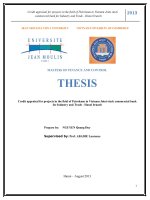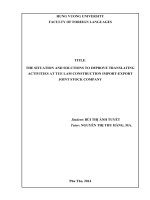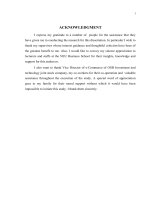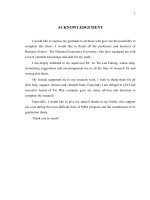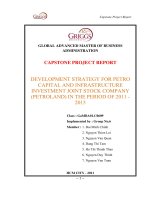managerial competency for middle managers at tin phat construction and commerce joint stock company
Bạn đang xem bản rút gọn của tài liệu. Xem và tải ngay bản đầy đủ của tài liệu tại đây (825.42 KB, 103 trang )
ACKNOWLEDGEMENT
I would like to express my gratitude to all those who gave me the possibility to
complete this thesis. I would like to thank all the professors and lecturers of
Business School - The National Economics University, who have equipped me with
a lot of valuable knowledge and skill for my study.
I am deeply indebted to my supervisor Dr. Lê Thị Lan Hương, whose help,
stimulating suggestions and encouragement me in all the time of research for and
writing this thesis.
My friends supported me in my research work. I want to thank them for all
their help, support, interest and valuable hints. Especially I am obliged to CEO and
executive board of Tin Phat company gave me many advices and direction to
complete the research.
Especially, I would like to give my special thanks to my family who support
me a lot during the most difficult time of MBA program and the compliment of its
graduation thesis.
Thank you so much!
11
TABLE OF CONTENTS
22
ABBREVIATION
BOD Board of Directors
BOM Board of Management
DEPT Department
HR Human Resources
GD General Director
TinPhat Co Tin Phat Construction and Commerce Joint Stock Company
Vigecam Vietnam General of Agricultural Materials Corporation Limited
33
LIST OT TABLES
LIST OF FIGURES
44
EXECUTIVE SUMMARY
Human resource is the most concern of almost companies in today’s rapid
changing and uncertain business environment. Organizations or companies might
have more success if the whole function of Human resources was treated as a mirror
image to the commercial brand, bringing executive management, marketing,
operations, finance and the other critical functions together working under one
organizational strategy.
Human resource is the main factor in the firm’s achievement. Middle
management is one important component of human resources that ensure
management quality successfully. Middle managers are responsible for
implementing goals set by BOD. Middle managers are also the connection between
upper managers and staff. They can motivate and assist their supervisors to achieve
business objectives of the company. They may also communicate upward, give
suggestions and feedback to BOD. Thus, the competency of middle managers is
very significant. However, in fact, managerial competencies of middle managers at
Tin Phat Co do not satisfy the needs of work. Some requirements that the BOD
have requested were not implemented sufficiently.
In order to help Tin Phat Co find out the sufficient way to enhance the
managerial competencies of Middle managers, the author has selected a research
topic on “Managerial Competency for Middle Managers at Tin Phat Co”. The
research objectives of this study are: (1)- To clarify the competency requirements of
the middle managers at Tin Phat Co; (2)- To analyze the current middle managers
competencies to find out the gap between required and current competencies of the
middle managers at Tin Phat Co; and (3)- To recommend some solutions to
restricting and to reducing the gap to helps middle managers to work more
effectively.
Based on the Theoretical framework of competency and managerial
competency, competency model, competency assessment process, in-depth
55
interviews for BOD was implemented to find out the required competency of
Middle managers. A survey with 5-mark-scale was designed to evaluate the needed
managerial competencies.
For middle managers and the staffs, the same survey was carried out to
indentify about the current managerial competencies of middle managers at Tin
Phat Co.
This survey was expected to implement with 85 persons, but actually only 61
persons including 04 member of BOD, 18 middle managers and 39 subordinates
were participated in this study.
The in depth - interview was done only for members of BOD. They are Mr
Đỗ Trọng Hiếu, chairman of BOD; Mr. Đỗ Mạnh Hoàng, general director and 02
vice general directors, Mr. Ngô Văn Thúy and Mr. Trần Văn Huấn.
This research had identified the gap between the requirement and current
managerial competencies of middle managers at Tin Phat Co based on 14 given
factors. Despite the fact that middle managers at Tin Phat Co were fulfilling their
current job, the managerial competencies were still lower than the requirement.
The largest gap is in Communication Skill 1.40 points. It means that Middle
managers of Tin Phat Co need to improve their communication skill more to
communicate effectively with the BOD and their subordinates. The Attitude of the
management of middle managers at Tin Phat Co is rated as satisfactory, however,
short courses to update the needed information are required.
To resolve these gaps, several solutions have been proposed in training and
non- training solutions to improve managerial competencies and bridge the current
gaps. The training solutions will focus on improving Middle managers competency.
The non-training solutions will focus on enhancing the HR system of the Tin Phat
Co, as follows: Create dynamics for middle managers to work effectively at Tin
Phat Co; Improving the criteria for evaluating managers of the company; Improving
the standard of each positions, quality for planning, and recruitment.
66
CHAPTER 1
INTRODUCTION
1.1. Rationale
Human resource is the most concern of almost companies in today’s rapid
changing and uncertain business environment. Organizations or companies might
have more success if the whole function of Human resources was treated as a mirror
image to the commercial brand, bringing executive management, marketing,
operations, finance and the other critical functions together working under one
organizational strategy.
The role of middle managers is very important with the development of a
company. Middle managers are responsible for implementing goals set by BOD.
Middle managers are also the connection between upper managers and staff. They
can motivate and assist their supervisors to achieve business objectives. They may
also communicate upward; give suggestions and feedback to BOD. Since Middle
managers are more involved in the day-to-day work of the company, they can
provide valuable information to upper managers to help improve the business
objectives as well as the quality of company’s human resources.
Tin Phat Construction and Commerce Joint Stock Company (Tin Phat Co) is
a member of the Vietnam Agricultural Materials Corporation (Vigecam). The Tin
Phat Co was founded at Hanoi and registered for business activities at the Hanoi
Department for Planning and Investment. Function and duties of the Tin Phat Co are
investment performance of construction business serving the Agricultural sector and
others. Tin Phat Co’s objective is how to develop itself for being commensurate
with the growing development of Agricultural Materials Corporation in accordance
with economic transition into market economy of the country. By 2018, the
company will develop and stabilize the business in three main areas: construction
services, investment and management of estate and materials business.
77
To achieve this objective, one important factor is that the Tin Phat Co must
improve the quality of human resources. The Company's current human resources
can only meet the requirement of current activities and for the long-term goals it
seems impossible in terms of both quantity and quality.
As mentioned above, middle managers play a very important role in the
company. Therefore, assessing competencies of middle managers is an urgent and
necessary task of Tin Phat Co. This helps to create value not only for the company
but also for individuals. By assessing competencies of middle managers, Tin Phat
Co can tackle with the problems that they are facing with and identify the
performance of middle managers in comparison with the required competencies of
the company. Moreover, competency assessment can help middle managers to
understand where they are and to identify their strengths and weaknesses
objectively.
Being aware of this I would like to study the topic: “Managerial competency
for middle managers at Tin Phat Construction and Commerce Joint Stock
Company” in order to develop and propose some recommendations for the
assessment and improvement of middle managers competencies. By improving
middle managers competencies, management competency of Tin Phat Co will also
be improved to meet the required competency for a development of the company.
1.2. Research objectives
The research objectives of this study are:
- To clarify the managerial competency requirements of the middle managers
at Tin Phat Co;
- To analyze the current managerial competencies of middle managers to find
out the gap between required and current competencies of the middle managers at
Tin Phat Co;
- To recommend some solutions to improve managerial competencies for
middle managers to work more effectively.
88
1.3. Research questions
In order to achieved the above objectives the thesis will address the
following research questions:
- Which are the requirements of competencies needed for middle managers at
Tin Phat Co?
- What are the current competencies of middle managers at Tin Phat Co?
- What are the gaps between current middle managers competencies and
requirement need at Tin Phat Co?
- What are solutions to improving middle managers competencies?
1.4. Research methodology
1.4.1 Research process
The research methodology could be summed up as the chart below:
TinPhat Company’s objectives
TinPhat Company middle manager’s job analysis objectives
In-depth interview and survey BOD
Survey BOD
Survey middle managers
Current managerial competency
Survey staff
Required managerial competency
99
Recommendations
1.4.2. Collecting data
1.4.2.1. Secondary data:
The secondary data are collected based on the desk study from the following sources:
- Theories, research methodology and approaches…are gained from MBA
curriculum such as the Managing Human Resources: Staffing, Employee
Development, Compensation, Governance; Research methods for business – a skill
building approach etc.
- Roles, functions, responsibilities and activities of studied subjects are
gained from Tin Phat Co’s annual reports, policies and legal documents regarding
the tasks and mandates of Departments.
- Reference on scientific facts, information about socio, economy, labor
markets and policies related to studied subjects are gained from newspapers,
magazines and websites.
1.4.2.2. Primary data
a. In-depth interview
In-depth interviews were performed with 04 members of Board of Directors,
including Chairman, CEO and 02 other members.
Information collected from in-depth interviews are:
- General information about Tin Phat Co.
- Company’s performance during period 2010-2103
- Strategic and growth orientation of the company
- Orientation for HR development company in the next 05 years.
1010
- Required competencies of middle mangers at Tin Phat Co. and the current
recommendation to improve their managerial competencies.
b. Survey
* Middle managers:
All middle managers of companies have involved in the survey. They are 08
heads and 10 vice heads coming from 08 divisions of the company.
Questions were designed with 03 sections: The first section is a general
guidance for the survey; the second part is an assessment component of the
surveyed participants by giving points; the third is a general information of the
surveyed participants and their personal opinion or remarks (optional).
Middle managers conducted self-assessment and assessment to their
colleagues.
* Staff:
There were 39 staffs involved in this survey, coming from 08 divisions of the
company.
They were selected by convenience method, it mean that they are selected
have on related bet there is author. Survey questions were sent to staffs directly and
got their feedbacks after 03 days.
Similar to those for middle managers, the designed questionnaires for staffs
included 03 sections: The first section is a general guidance for the survey; the
second part is an assessment component of the surveyed participants by giving
points; the third is a general information of the surveyed participants and their
personal opinion or remarks (optional).
Staffs conducted assessment for their direct managers, who are the heads and
vice heads of their division.
1.4.3. Data analysis
The author used the Microsoft Excel and SPSS to analyze data collected.
1111
1.5. Research scope
- Study object: Managerial competencies of middle managers at Tin Phat Co,
including Heads and Vice head of all Departments.
- Study location: Tin Phat Company headquarter in Ha Noi
- Timing: Secondary data will be collected from 2009 up to now.
Primary data will be collected from April to June 2013.
1.6. Research structure
Chapter 1 - Introduction
Chapter 2 -Theoretical Background on managerial competency
Chapter 3 -Required managerial competencies of middle managers at Tin Phat Co
Chapter 4 -Current managerial competencies of middle managers at Tin Phat Co
Chapter 5 -Recommendation to improve middle managers’ managerial
competencies at Tin Phat Co
1212
CHAPTER 2
THEORETICAL BACKGROUND ON
MANAGERIAL COMPETENCY OF MIDDLE MANAGER
2.1. Nature of managerial competency
2.1.1. Definition of managerial competency:
The first definition of management competency was presented by Boyatzis
(1982) with clusters of competencies as “A capacity that exists in a person that leads
to behavior that meets the job demands within parameters of organizational
environment, and that, in turn brings about desired results”.
After that, there are some definitions from different researches. According to
Albanese (1989) “Competencies are personal characteristics that contribute to
effective managerial performance”, while Hayes (1979) presented “Competencies
are generic knowledge motive, trait, social role or a skill of a person linked to
superior performance on the job”.
Over the past years, human resource and organizational development professionals
have generated a lot of interest in the notion of competencies as a key element and
measure of human performance. Competencies are becoming a frequently-used and
written-about means for organizational applications such as:
• Defining the factors for a success of jobs (i.e., work) and work roles within
the organization.
• Assessing the current performance and future development needs of
persons holding jobs and roles.
• Mapping succession possibilities for employees within the organization
• Assigning compensation grades and levels to concrete jobs and roles
• Selecting applicants for open positions, using competency-based
interviewing techniques
1313
2.1.2. Middle managers and role of middle managers
Middle management consists of any layer of supervisors at an organization
that acts as a buffer between the top management and non-management workers.
These managers encompass a variety of titles and roles but share many common
duties. A middle manager is found in nearly every sector of business, including white-
collar jobs, factories, government and the service industry. Many times,
the middle management's job involves handling the flow of information both from
upper management to the workers and from the workers up to the members of the
senior management staff.
Middle management can hold a very specific niche within an organization, for
example, an accounting manager that oversees a group of lower accountants and
reports to an owner. It can also be more broader, such as a manager who oversees all
departments and reports to a boss. In larger organizations, there also can be several
layers of middle management, meaning that one middle manager is in a chain of
command that requires him or her to report to a middle manager at a higher level.
The primary responsibility of middle managers is to keep the organization
moving forward its objectives and making profits so that members of the senior
management level can focus on larger decisions about budgets, goals and vision.
Maintaining worker productivity is a large responsibility for middle managers, and
often the productivity standards are set by senior management level. Maintaining
employee’s satisfaction is another duty of middle management, meaning
that middle managers must work with disgruntled workers to solve problems and
reward hard work and success to keep members of the workforce happy.
A middle manager also must help new employees and managers to understand their
jobs and responsibilities. A manager must understand all of the jobs belonging to
them such as, what is expectation of those jobs and how to report to upper
management appropriately.
Communication is often the largest responsibility of members of
the middle management. Most often, when new goals, initiatives or rules are created
1414
by upper management level, they are passed to the middle manager for distribution
to the workers. A middle manager must interpret these changes and effectively
communicate them to the workers and answer questions that might arise.
A less common, but still important, role of a middle manager is
communicating information in to the upper management. When workers are
unhappy or have suggestions that cannot be solved by middle management, it is that
manager's responsibility to speak with the organization's leaders.
The middle manager must know the appropriate way to approach members
of the upper management level to express this concern.
2.1.3. Management function of middle managers
The most commonly cited functions of management are planning,
organizing, leading, and controlling, although there are several additional functions.
Should be taken into consideration. These functions provide a useful way of
classifying information about management, and most basic texts since the 1950s,
Henri Fayol was the first person to identify elements or functions of management in
his classic 1916 book “Administration Industrielle et Generale”. Fayol was the
managing director of a large French coal-mining firm and based his book largely on
his experiences as a practitioner of management. Fayol defined five functions, or
elements of management: planning, organizing, commanding, coordinating, and
controlling. Fayol argued that these functions are universal, in the sense that all
managers performed them in the course of their jobs, whether the managers worked
in business, military, government, religions, or philanthropic undertakings.
Fayol defined planning in terms of forecasting future conditions, setting
objectives, and developing means to attain objectives. Fayol recognized that
effective planning must also take into account unexpected contingencies that might
arise and did not advocate rigid and inflexible plans. Fayol defined organizing as
making provision for the structuring of activities and relationships within the firm
and also the recruiting, evaluation, and training of personnel.
1515
According to Fayol, commanding as a managerial function concerned the
personal supervision of subordinates and involved inspiring them to put forth
unified effort to achieve objectives. Fayol emphasized the importance of managers
understanding the people who worked for them, setting a good example, treating
subordinates in a manner consistent with firm policy, delegating, and
communicating through meetings and conferences.
Fayol considered the function of coordination as harmonizing all of the
various activities of the firm. Most later experts did not retain Fayol's coordination
function as a separate function of management but regarded it as a necessary
component of all the other management functions. Fayol defined the control
function in terms of ensuring that everything occurs within the parameters of the
plan and accompanying principles. The purpose of control was to identify
deviations from objectives and plans and to take corrective action.
Fayol's work was not widely known outside Europe until 1949, when a
translation of his work appeared in the United States. Nevertheless, his discussion
of the practice of management as a process consisting of specific functions had a
tremendous influence on early management texts that appeared in the 1950s.
Management pioneers such as George Terry, Harold Koontz, Cyril
O'Donnell, and Ralph Davis all published management texts in the 1950s that
defined management as a process consisting of a set of interdependent functions.
Collectively, these and several other management experts became identified with
what came to be known as the process school of management.
According to the process school, management is a distinct intellectual
activity consisting of several functions. The process theorists believe that all
managers, regardless of their industry, organization, or level of management,
engage in the functions of management. The process school of management became
a dominant paradigm for studying management and the functions of management
became the most common way of describing the nature of managerial work.
Criticism of the functional approach to management
1616
By the early 1970s, some experts suggested that the functions of management as
described by Fayol and others of the process school of management were not an
accurate description of the reality of managers' jobs. Chief among the critics of the
functional approach was Henry Mintzberg.
Mintzberg argued that the functional or process school of management was
"folklore" and that functions of management such as planning, organizing, leading,
and controlling did not accurately depict the chaotic nature of managerial work. He
felt that the functional approach to the managerial job falsely conveyed a sense that
managers carefully and deliberately evaluated information before making
management decisions.
Based upon an observational study of five executives, Mintzberg concluded
that the work managers actually performed could best be represented by three sets
of roles, or activities: interpersonal roles, informational roles, and decision-making
roles. He described the interpersonal roles as consisting of figurehead, leader, and
liaison. He identified three informational roles: monitor, disseminator, and
spokesperson. Finally, he described four decision-making roles that included
entrepreneur, disturbance handler, resource allocation, and negotiator.
Mintzberg's challenge to the usefulness of the functions of management and
the process school attracted a tremendous amount of attention and generated several
empirical studies designed to determine whether his or Fayol's description of the
managerial job was most accurate. While this research did indicate that managers
performed at least some of the roles Mintzberg identified, there was little in the
findings that suggested that the functions of management were not a useful way of
describing managerial work.
Scholars continue to debate this question. Research by David Lamond
suggests that both approaches had some validity, with Fayol's approach describing
the ideal management job and Mintzberg describing the day-to-day activities of
managers. Thus, the general conclusion seems to be that while Mintzberg offered a
genuine insight into the daily activities of practicing managers, the functions of
1717
management still provides a very useful way of classifying the activities managers
engage in as they attempt to achieve organizational goals.
Planning
Planning is the function of management that involves setting objectives and
determining a course of action for achieving these objectives. Planning requires that
managers be aware of environmental conditions facing their organization and
forecast future conditions. It also requires that managers be good decision-makers.
Planning is a process consisting of several steps. The process begins with
environmental scanning, which simply means that planners must be aware of the
critical contingencies facing their organization in terms of economic conditions,
their competitors, and their customers. Planners must then attempt to forecast future
conditions. These forecasts form the basis for planning.
Planners must establish objectives, which are statements of what needs to be
achieved and when. Planners must then identify alternative courses of action for
achieving objectives. After evaluating the various alternatives, planners must make
decisions about the best courses of action for achieving objectives. They must then
formulate necessary steps and ensure effective implementation of plans. Finally,
planners must constantly evaluate the success of their plans and take corrective
action when necessary.
Organizing
Organizing is the function of management that involves developing an
organizational structure and allocating human resources to ensure the
accomplishment of objectives. The structure of the organization is the framework
within which effort is coordinated. The structure is usually represented by an
organization chart, which provides a graphic representation of the chain of
command within an organization. Decisions made about the structure of an
organization are generally referred to as "organizational design" decisions.
Organizing also involves the design of individual jobs within the
organization. Decisions must be made about the duties and responsibilities of
1818
individual jobs as well as the manner in which the duties should be carried out.
Decisions made about the nature of jobs within the organization are generally called
"job design" decisions.
Organizing at the level of the organization involves deciding how best to
departmentalize, or cluster jobs into departments to effectively coordinate effort.
There are many different ways to departmentalize, including organizing by function,
product, geography or customer. Many larger organizations utilize multiple methods
of departmentalization. Organizing at the level of job involves how best to design
individual jobs to most effectively use human resources.
Traditionally, job design was based on principles of division of labor and
specialization, which assumed that the more narrow the job content, the more
proficient the individual performing the job could become. However, experience has
shown that it is possible for jobs to become too narrow and specialized. When this
happens, negative outcomes result, including decreased job satisfaction and
organizational commitment and increased absenteeism and turnover.
Recently many organizations have attempted to strike a balance between the
need for worker specialization and the need for workers to have jobs that entail
variety and autonomy. Many jobs are now designed based on such principles as job
enrichment and teamwork.
Leading
Leading involves influencing others toward the attainment of organizational
objectives. Effective leading requires the manager to motivate subordinates,
communicate effectively, and effectively use power. If managers are effective
leaders, their subordinates will be enthusiastic about exerting effort toward the
attainment of organizational objectives.
To become effective at leading, managers must first understand their
subordinates' personalities, values, attitudes, and emotions. Therefore, the behavioral
sciences have made many contributions to the understanding of this function of
1919
management. Personality research and studies of job attitudes provide important
information as to how managers can most effectively lead subordinates.
Studies of motivation and motivation theory provide important information
about the ways in which workers can be energized to put forth productive effort.
Studies of communication provide direction as to how managers can effectively and
persuasively communicate. Studies of leadership and leadership style provide
information regarding questions such as, "What makes a manager a good leader?" and
"In what situations are certain leadership styles most appropriate and effective?"
Controlling
Controlling involves ensuring that performance does not deviate from standards.
Controlling consists of three steps, which include establishing performance standards,
comparing actual performance against standards, and taking corrective action when
necessary. Performance standards are often stated in monetary terms such as revenue,
costs, or profits, but may also be stated in other terms, such as units produced, number
of defective products, or levels of customer service.
The measurement of performance can be done in several ways, depending on
the performance standards, including financial statements, sales reports, production
results, customer satisfaction, and formal performance appraisals. Managers at all
levels engage in the managerial function of controlling to some degree.
The managerial function of controlling should not be confused with control
in the behavioral or manipulative sense. This function does not imply that managers
should attempt to control or manipulate the personalities, values, attitudes, or
emotions of their subordinates. Instead, this function of management concerns the
manager's role in taking necessary actions to ensure that the work-related activities
of subordinates are consistent with and contributing toward the accomplishment of
organizational and departmental objectives.
Effective controlling requires the existence of plans, since planning provides the
necessary performance standards or objectives. Controlling also requires a clear
understanding of where responsibility for deviations from standards lies. Two
2020
traditional control techniques are the budget and the performance audit. Although
controlling is often thought of in terms of financial criteria, managers must also control
production/operations processes, procedures for delivery of services, compliance with
company policies, and many other activities within the organization.
The management functions of planning, organizing, leading, and controlling
are widely considered to be the best means of describing the manager's job as well
as the best way to classify accumulated knowledge about the study of management.
Although there have been tremendous changes in the environment faced by
managers and the tools used by managers to perform their roles, managers still
perform these essential functions.
2.2. Managerial competency assessment for Middle managers
2.2.1. Managerial competencies components
Competencies which are considered essential for employees with managerial or
supervisory responsibility in any functional area including directors and senior posts.
The competencies are observable or measurable knowledge, skills and attitudes (KSA)
and these KSA’s must distinguish between superior and other performers.
Competency = Knowledge + Skills + Attitude
KNOWLEDGE
SKILLS
ATTITUDE
COMPETENCY
Outstanding
Performance of
Task or activities
Figure 2 Definition of Competency
(Source: Author’s consolidation from the research)
Knowledge:
Knowledge is theoretical or practical understands about subjects or events.
Knowledge is gained through learning or experiencing. It is expertise and skills
acquired by a person through experience of education. It is what is known in a
2121
particular field or in total; facts and information or awareness or familiarity gained by
experience of a fact or situation. Knowledge acquisition involves complex cognitive
processes: perception, learning, communication, association and reasoning. The term
knowledge is also used to mean the confident understanding of a subject with the
ability to use it for a specific purpose.
In glance, it refers to a context of information relevant to job performance such
as before performing a job we have to have knowledge of policies and procedures. For
trade and service staffs, knowledge is perception about domestic and international
business, economic trends, competitors, service process, national and international
laws, regulations
Skill:
Skill usually requires certain environmental stimulate and situation to be
accessed the level of it. People especially in our modern society today need to a
broad range of skill to find a job. And according to a recent study, skills of
employees have to follow the change of technology and workplace.
In the domain of work, some general skills would include time management,
teamwork and leadership, self motivation and others, whereas domain-specific
skills would be useful only for a certain job.
In the managers' point of view, skill is also the practice of understanding.
Well-implemented skills management should identify the skills that job roles
require, the skills of individual employees, and the gap between two of these.
Attitudes:
Attitudes refer to both behaviors and styles of people. It may contain manual
dexterity, visual and conceptual thinking. Sometime it is called as personal
characteristics include traits, motives, styles, personalities, values, attributes, and
many others. Attitude plays a very important role, as it decides effectiveness of
almost other factors.
Attitudes are composed from various forms of judgments. The affective
response is a physiological response that expresses an individual's preference for an
2222
entity. The behavioral intention is a verbal indication of the intention of an
individual. The cognitive response is a cognitive evaluation of the entity to form an
attitude. Most attitudes in individuals are a result of observational learning from
their environment.
Attitudes are positive, negative or neutral views of an "attitude object" i.e. a
person, behavior or event. People can also be "ambivalent" towards a target,
meaning that they simultaneously possess a positive and a negative bias towards the
attitude in question.
2.2.2. Managerial competency assessment methods for Middle managers
*Managerial competency model
A traditional assessment for managerial competency model was used for a
long time. In this model, managers interview and discuss with the employees for
their work performances, usually it has been carried out annually or biennial. This
discussion is based on the managers' observations of the employees' abilities and
performances of task noting in the job description. In reality, a company uses
competency model to identify the current competency of candidate for recruitment
and selection, or to identify the gaps that employees need to bridge for career
development or promotion.
The competency model is a description if those competencies possessed by
the top performers in a specific job. In another way, a competency model is like a
blueprint for striking performance. Therefore, as a top manager in a company or an
organization, competency model can help to improve the selection of people for
jobs; develop skills and characteristics that lead to enhance effectiveness and
productivity; provide a consistent framework for human resources applications; and
build alignment with organizational value and strategy.
Competency model has two mainly common types:
- The “single-job” managerial competency model: is like a list of
requirements and achievements that the job holders must meet and reach for one
specific job only.
2323
- The “one-size-fit-all” managerial competency model: is like a standard for
all the applications and basing on this model, the human resource professionals seek
and find the appropriate candidates for the jobs.
However, the “one-size-fit-all” competency model is no longer used
popularly. It has many disadvantages causing detriment to the quality of recruitment
and applications.
*Managerial competency methods
The importance of competency assessment is not only the thing based on this,
company’s leaders that could find the right employees but also is tied to salary offers.
After studying, I mention below four widely used methods for competency assessment:
Self competency assessment
In this thesis, the Middle managers assess their competency themselves. This
method allows us to understand thoroughly about their strong or weak points. By
doing this, it can encourage the Middle managers to take responsibilities for their own
performance and also to discuss themselves with their BOD. It is only used as an
extra part of competency assessment because the candidates tend to over-estimate
their strengths and abilities and that sometimes does not make any sense to the BOD.
Subordinates competency assessment
This assessment allows the subordinates of the Middle managers to give their
comments and to express their satisfactions about the jobs, the results and the
interaction between them and Middle managers. This method is quite effective
because of a deep understanding and experiences which the subordinates have with
their Middle managers. Their comments sometimes can be used as requirements for
Middle managers.
However, there are also some drawbacks of this method. Subordinates
assessment could be incorrect because of the misunderstanding between
subordinates and middle managers about the purpose, strategy or working process.
Superior competency assessment
2424
Despite of different departments or responsibilities that employees (or
particularly Middle managers in this thesis) are holding, they are at the same
community and the body of the organization. Hence, if someone does not meet the
required competency for his jobs, this could lead to the failure of others' works.
According to this, superiors themselves have a lot of experiences and much time to
understand each other so they could certainly give the appraisals for individual
employee.
Nevertheless, sometimes the assessments are too harsh due to the high
requirements that they put in others. More seriously, after failures or mistakes, they
possibly have a trend to put the blame on others.
The 360 degree competency assessment
This is the system in which assessment is archived by collecting feedback
from many individuals namely, the BOD, different Middle managers, subordinates
from all the departments, external customers, and Middle managers themselves. In
this sense, 360 degree competency assessment is like a jury in a court and the
assessment depending on this is more correct, more independent, and more
legitimate. It also encourages the Middle managers much more accountable to their
various internal and external people because these people could have feedback on
their competency.
But this method takes much time to be done and therefore it is quite
expensive. To have a complete 360 degree assessment, organizations have to invest
time and money not only in doing this appraisal but also in training for all
employees so that they have sufficient knowledge and skills to do this assessment.
2525

